This post may contain affiliate links. Please see our disclosure policy.
Using Pomona’s Pectin opens up a whole new world of flexibility for homemade jams and jellies. Unlike traditional pectins, Pomona’s lets you use low or no sugar, alternative sweeteners, and even unusual ingredients, while still getting a reliable set. Once you learn how the process works, you can adapt almost any recipe to fit your taste and pantry.
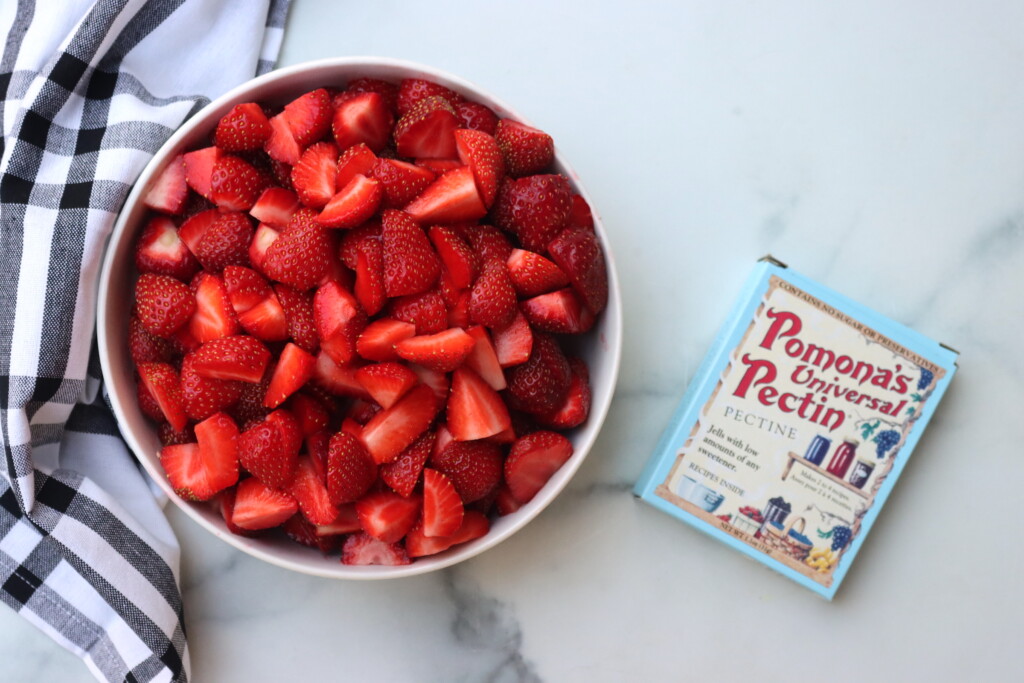
If you’re looking to make homemade jam with less sugar, or none at all, Pomona’s Universal Pectin is a game changer. Unlike traditional pectins that rely on high sugar content to set properly, Pomona’s uses a calcium-based system that gives you complete control over how much (or how little) sweetener you add. That means you can use sugar, honey, maple syrup, agave, or no sweetener at all—whatever suits your taste or dietary needs.
It’s the pectin that most people turn to when they’re looking for natural ingredients, as it’s really the only one that doesn’t contain any funny stuff. Just fruit pectin, and a bit of calcium to activate it.
This flexibility does require a different process, though. If you’re used to Sure-Jell or Ball pectin, the method might feel a little unfamiliar at first. But once you learn the steps, it’s incredibly easy, and the results are fantastic. The fruit flavor stays bright and fresh, and you don’t have to boil your jam into a sticky mess just to get it to set.
How Pomona’s Pectin Works
With traditional boxed pectins, sugar plays a critical role in helping the pectin gel. That’s why so many classic jam recipes call for 5 to 7 cups of sugar for every 4 cups of fruit. Pomona’s flips that logic on its head.
Pomona’s Pectin doesn’t rely on sugar to gel. Instead, it uses calcium to activate the gelling process. Every box of Pomona’s comes with a small packet of calcium powder, which you mix with water to create calcium water. Just a teaspoon or two of this mixture, added to your mashed fruit, is all it takes to get a reliable set, no matter how much sweetener you use (or don’t use).
Because sugar isn’t needed for the jam to gel, you can sweeten to taste. That means you can use a modest amount of sugar or switch to natural options like honey or maple syrup. You can even make fully unsweetened preserves if that’s what you prefer.
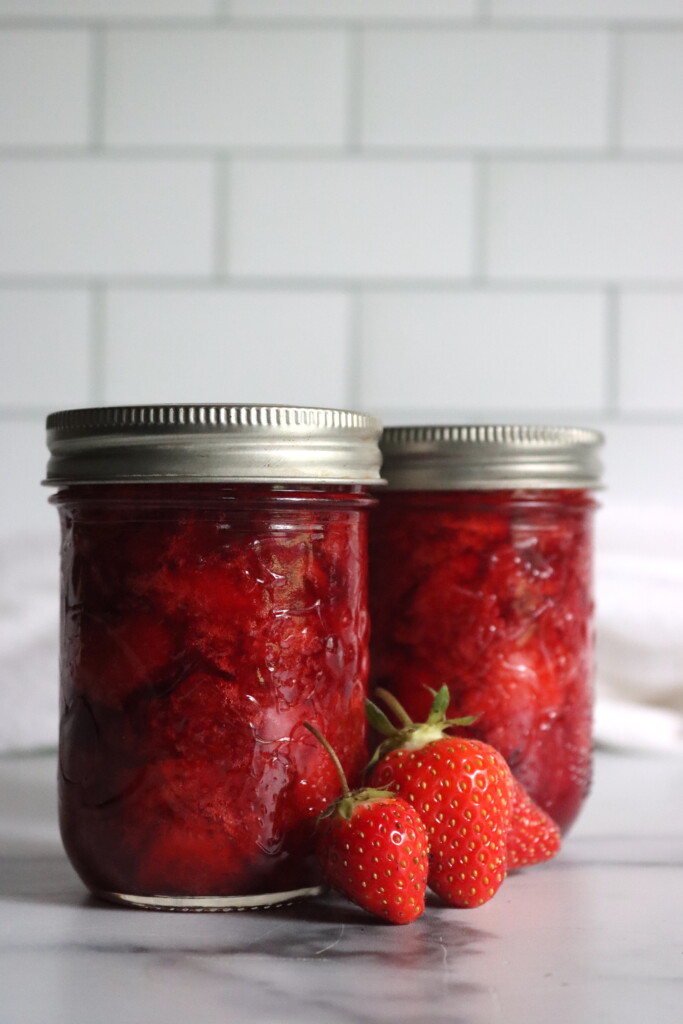
Using Pomona’s Pectin
Using Pomona’s Pectin is a bit different from the standard jam-making process, and it helps to understand how the steps shift. One of the most important changes is that you add calcium water directly to the mashed fruit before cooking, typically 1 to 2 teaspoons. This is essential because Pomona’s relies on calcium, not sugar, to help the jam gel.
Another key difference is that the pectin powder is mixed into the sweetener before it’s added to the fruit. This might feel backward if you’re used to traditional pectins, but it helps prevent clumping and ensures the pectin dissolves evenly. Whether you’re using sugar, honey, maple syrup, or another sweetener, stir the pectin into it first.
From there, you bring the fruit and calcium water mixture to a boil on its own. Once it’s boiling, you stir in the pectin-sweetener mixture and return the pot to a full boil for just 1 to 2 minutes to activate the pectin. Then it’s ready to ladle into jars and process.
Finally, you get complete control over how much sweetener to use. You can add as little as ¼ cup of sugar (or honey, maple syrup, etc.) for every 4 cups of fruit, or increase it to 1 cup if you prefer something sweeter. Most fruits taste great somewhere in the middle, around ⅓ to ½ cup of sweetener, but it’s entirely up to your taste preferences.
Converting Regular Jam & Jelly Recipes to Pomona’s Pectin
One of the biggest advantages of Pomona’s Pectin is flexibility—it lets you control the amount and type of sweetener you use. But converting a standard jam or jelly recipe to Pomona’s isn’t as simple as just swapping the pectin. There are a few key things to keep in mind to ensure a safe, reliable set and a properly acidified preserve.
First, most boxed pectins (like Sure-Jell or Ball) include citric acid in the powder itself. This helps acidify the jam to ensure safe water bath canning, especially in borderline-acid fruits. Pomona’s doesn’t include citric acid, so when you convert a recipe, you may need to add lemon juice to ensure the pH stays safely below 4.6 for water bath canning.
This usually isn’t an issue for most fruit jams—especially things like strawberry, raspberry, or plum—since the fruit itself is already acidic. But for recipes that rely on the added citric acid in traditional pectin, you’ll need to add acid manually.
Take old-fashioned corn cob jelly, for example. That’s a tested recipe from the National Center for Home Food Preservation (NCHFP), and it relies on boxed pectin both to gel and to supply citric acid to acidify what is essentially a corn-flavored tea. If you’re using Pomona’s instead, you’ll need to add 2 tablespoons of bottled lemon juice per batch to safely acidify it for canning.
The same goes for flower jellies like dandelion jelly or violet jelly. These recipes often start with a mild floral tea that isn’t acidic on its own. When using Pomona’s Pectin, you should add ¼ cup (4 tablespoons) of bottled lemon juice per 4-cup batch of liquid. This ensures the jelly reaches a safe pH and is shelf-stable after processing.
Tips for Best Results
Don’t skip the calcium water. That’s what allows Pomona’s to gel without sugar. If you forget it, your jam won’t set no matter how much pectin you add.
Use accurate measurements. Pomona’s is very concentrated, and too much pectin can lead to an overly firm or rubbery jam. If you’re unsure, start with a smaller amount and increase if needed in future batches.
You can double batches as long as you scale both the pectin and calcium water proportionally. Just be sure to stir thoroughly and return the mixture to a full boil after adding the pectin. Don’t increase beyond a double batch, as really bit batches have trouble cooking evenly and may not set quite right.
Don’t overcook. Unlike traditional recipes that require long boiling times, Pomona’s only needs to be boiled for 1 to 2 minutes after the pectin is added. This short cook time helps preserve the fruit’s color and flavor.
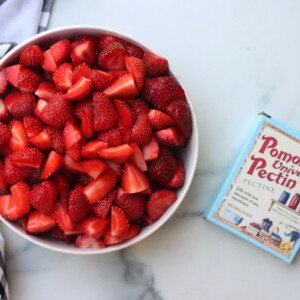
Low Sugar Jam with Pomona’s Pectin (Basic Recipe)
Ingredients
- 4 cups mashed fruit, about 6 to 8 cups whole fruit
- 2 tsp calcium water, prepared using Pomona’s instructions
- ¼ to 1 cup sugar, honey, or maple syrup (to taste)
- 2 tsp Pomona’s Pectin powder
Instructions
- Prepare calcium water: Mix ½ teaspoon calcium powder with ½ cup water in a small jar. Shake well. You’ll only need 2 teaspoons for this batch; store the rest in the fridge for future use.
- Prep jars and canner: Wash jars, lids, and bands. Set up your water bath canner and keep jars warm until ready to fill.
- Prepare fruit: Wash, hull, and mash your fruit. Measure exactly 4 cups and place in a saucepan. Add 2 teaspoons prepared calcium water and stir to combine.
- Mix sweetener and pectin: In a separate bowl, mix 2 teaspoons Pomona’s pectin powder with your chosen sweetener (¼ to 1 cup). Stir well to distribute evenly.
- Cook the fruit: Bring the fruit and calcium water mixture to a boil over medium-high heat.
- Add pectin-sweetener mixture: Stir in the pectin-sweetener mixture and return to a full boil, stirring constantly. Boil for 1–2 minutes, then remove from heat.
- Fill and close jars: Ladle hot jam into prepared jars, leaving ¼ inch headspace. Wipe rims clean, apply lids and rings, and tighten fingertip-tight.
- Water bath process: Process jars in a boiling water bath for 10 minutes (or 15 minutes if above 6,000 feet elevation). Let rest 5 minutes in the canner, then remove and cool undisturbed for 12–24 hours.
- Store: Check seals and label jars. Store in a cool, dark pantry for up to 18 months. Refrigerate any unsealed jars and use within a few weeks.
Notes
Nutrition
Nutrition information is automatically calculated, so should only be used as an approximation.
Recipes with Pomona’s Pectin
Pomona’s Pectin is available online and in many health food stores. Each box contains enough pectin and calcium powder for multiple batches, so it’s a great value if you plan to make jam throughout the season.
Looking for specific recipes using Pomona’s? Try these:
What are your favorite low sugar jam and jelly recipes? Leave me a note in the comments!
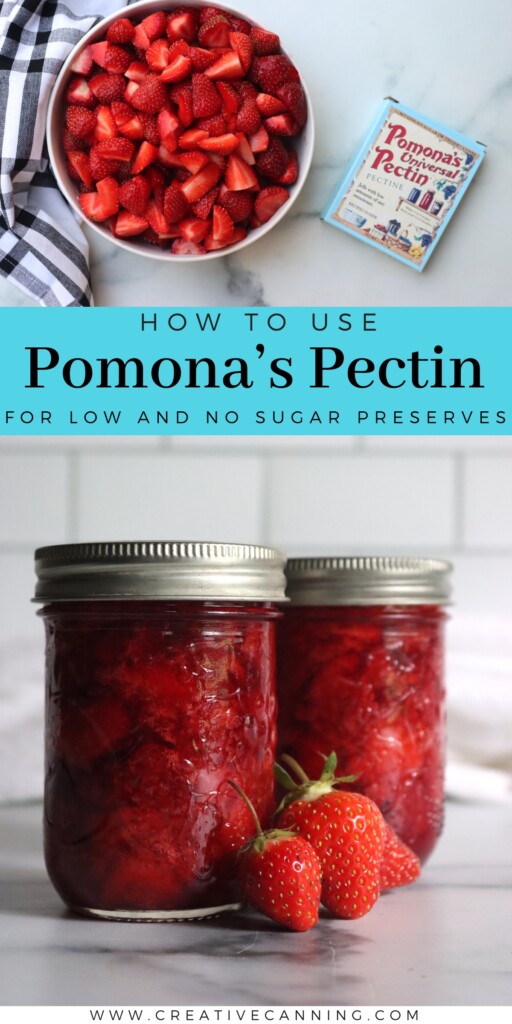
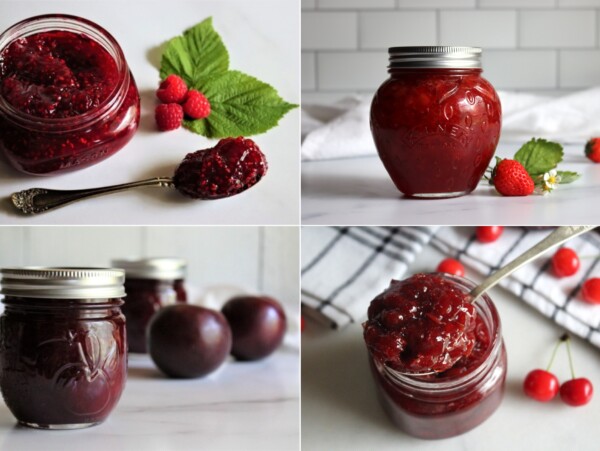
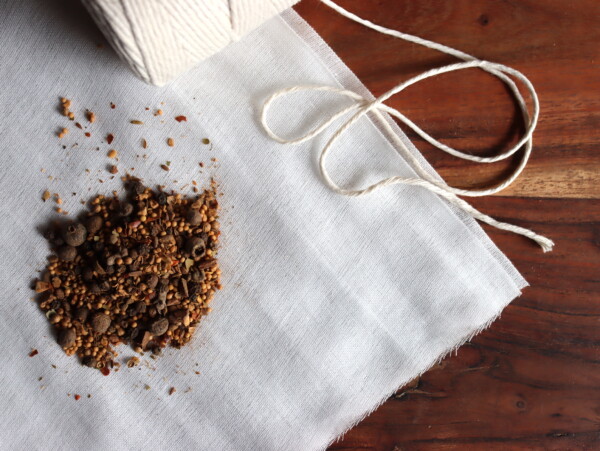
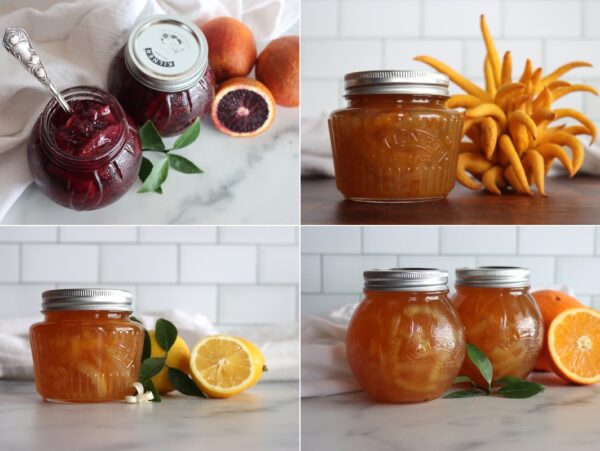
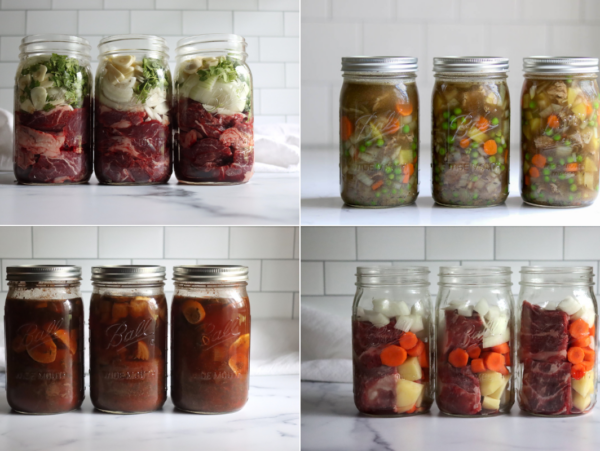
have been using Pomona for years as my man is diabetic: LOVE the recipes and have also referred to your website often: thank you
my query: trying to find a carrot jam recipe using POMONA product and they no long have it on the website: tempted to turn to ai to confirm substituting lemon juice for pineapple (store is far away and canned ‘stuff’ is getting pricey)
have you make carrot jam and would you be willing to post it?
Cheers
and thanks again for your great work and info
I have not made a carrot jam, that’s one of the few that I haven’t made yet! I did find a recipe for it on the Pomona’s website, it looks like they just changed the name to “Sunshine Marmalade”: https://pomonapectin.com/sunrise-marmalade/
In this particular recipe, it needs all the acidic things in there to balance the carrots to make it safe for canning, so don’t skip the oranges or pineapple.
I’ll add carrot jam to my list so I can try a few, thanks!
This is perfect timing for me. “Evil Twin” does not like overly sweet jams, so I got a box of Pomona pectin to try out by making a batch of plum jam for her.
We’ve been calling each other evil twin for as long as we can remember, so regardless of which of us you ask, ET refers to the other one. 🙂